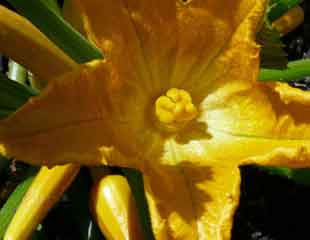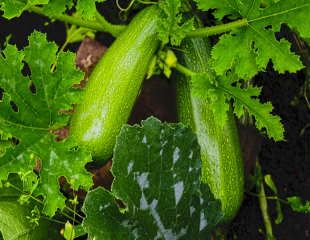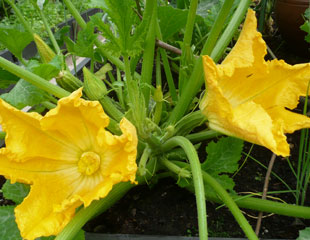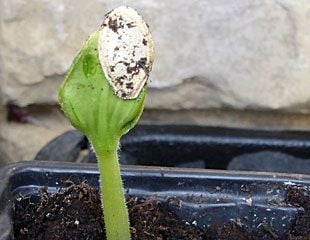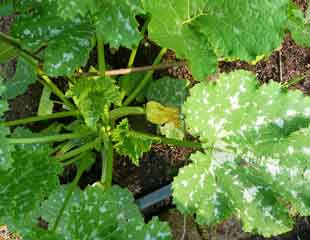How to Grow Courgettes
Courgettes are easy to grow and producing many fruits per plant, which generally means that two plants will produce ample courgettes for most families. Courgettes are not frost hardy. Don't plant courgettes until late May/June, after the last frost. Even then, if it is cold, or a chilly wind, cover with a cloche until the weather picks up.
Growing Courgettes from seed
Courgettes produce a large seed, which is easy to handle, and to germinate provided they have enough warmth. Place one seed in a small pot, cover with thin layer of compost and spray lightly with water. To maintain the right atmosphere, it is essential to cover either in propagator or with poly bag which needs to be secured with string or an elastic band to keep the plant firmly sealed in during the germination process.
Keep in a warm place until germination has taken place and then remove the bag or take out of the propagator. Don't leave them in the warm, covered area for too long; this produces leggy seedlings. Keep frost free until ready for planting out.
Growing courgettes in containers
Courgettes can be grown in containers, provided it is a large container. Whether growing courgettes in the ground or pots, Courgettes like plenty of organic material and when fruiting the plants will benefit from regular feeding. You can grow any variety of courgette in a container, if it is large enough, but in practical terms it is easier to grow the more compact varieties of courgette in containers. Worth checking out are: Bambino produces dark green smaller fruits; Raven another dark green variety; Patio Star, as the name suggests suitable for growing on a patio.

The RHS conducted a trial of courgettes (squashes and marrows) in 2021. Many varieties of courgette gained the RHS award of garden merit, Bambino and Raven were the only compact varieties to gain the award.
Watering Courgettes
A tip about watering small courgette plants, when they are small and before maturity. Take care not to over water them. Immature and small courgette plants are prone to rot at the stem neck, where it meets the soil, especially if the summer is cold or wet, or if the plant is over watered. It is important to avoid over watering, especially during the early stages of growth.
This is true also of cucumbers and squashes, of the same veg family. Avoid over watering in early stages.
The reverse is true once the plant is established. When in full growth, courgettes need regular watering and, if possible, to the roots not the leaves. One way of doing this is to sink a plastic bottle next to the plant when you plant it out, with the base cut out. This makes a funnel so that when you water into the bottle, it goes directly to the roots.
Once established, growing courgettes appreciate a weekly feed, proprietary tomato food does well.
Common problems when growing courgettes
As a Courgette plant matures, the leaves often get white markings on them as in the image left. This is nothing to worry about and the plant is healthy. It is part of the courgette leaf's appearance.
Cold weather: courgettes don't like it and will produce fewer fruits. This is because they need a lot of pollination and generally, when the weather is cool, there are fewer pollinators about.
This differs from powdery mildew, which can be a problem. Images and hints on how to deal with powdery mildew.
This also occurs if there is a preponderance of male flowers.
Poor pollination and the mystery of male and female flowers
Courgette plants produce male and female flowers. Only female flowers produce fruit after fertilisation with a male. A female courgette flower has a bump, or swelling at the base, which is the immature embryo fruit. The male flower is dead straight, no bumps. This is how you identify the male and female flowers.
Why is the difference important? Two reasons.
Firstly, sometimes early in the growing season there may be a glut of male flowers and some growers remove and thinning out the male flowers to encourage more female (fruiting) flowers.
Secondly, in the below the fruit has not come to maturity, because of a pollination failure. If this happens you can manually pollinate the plants, but you need to know which are the male and female flowers.
Why does my courgette look like this? Poor pollination
If your courgettes look like this, it is because of a lack of pollination.
This is common early in the growing season when pollinators are scarce, but also happens in bad summers or cool weather that reduces pollinator activity.
You can just pick the courgette off and wait for better results. You can also assist pollination by picking a male flower, remove outside leaves and then brush the anther (middle bit of male flower) over the inside of the female flower (stigma) and it should pollinate. One male flower can pollinate several females. This makes it sound as if growing courgettes is difficult; it's not, and normally the problem is the glut of courgettes, which is why most gardeners only grow a couple of plants. Because courgettes like it warm, they usually pick up later in the summer, so if there are no fruits early in the summer, there is no necessity to hand pollinate. You can just wait for the weather to improve.
Good varieties of Courgette to grow are 'El Greco' usually prolific, mid-green fruits and good disease resistance. 'Supremo' is compact, good for smaller gardens, or containers. If you are looking for colour, 'Parador' is a bright yellow variety and 'Defender' is a F1 green variety. These recommended varieties have the RHS award of garden merit in the 2021 trial.

